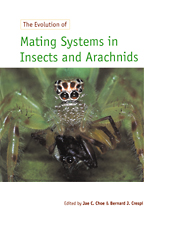Book contents
- Frontmatter
- Contents
- Contributors
- Acknowledgements
- Introduction
- 1 Evolutionary perspectives on insect mating
- 2 Sexual selection by cryptic female choice in insects and arachnids
- 3 Natural and sexual selection components of odonate mating patterns
- 4 Sexual selection in resource defense polygyny: lessons from territorial grasshoppers
- 5 Reproductive strategies of the crickets (Orthoptera: Gryllidae)
- 6 The evolution of edible ‘sperm sacs’ and other forms of courtship feeding in crickets, katydids and their kin (Orthoptera: Ensifera)
- 7 The evolution of mating systems in the Zoraptera: mating variations and sexual conflicts
- 8 The evolution of water strider mating systems: causes and consequences of sexual conflicts
- 9 Multiple mating, sperm competition, and cryptic female choice in the leaf beetles (Coleoptera: Chrysomelidae)
- 10 Firefly mating ecology, selection and evolution
- 11 Modern mating systems in archaic Holometabola: sexuality in neuropterid insects
- 12 Mating systems of parasitoid wasps
- 13 Fig–associated wasps: pollinators and parasites, sex–ratio adjustment and male polymorphism, population structure and its consequences
- 14 Evolution of mate–signaling in moths: phylogenetic considerations and predictions from the asymmetric tracking hypothesis
- 15 Sexual dimorphism, mating systems and ecology in butterflies
- 16 Lek behavior of insects
- 17 Mate choice and species isolation in swarming insects
- 18 Function and evolution of antlers and eye stalks in flies
- 19 Sex via the substrate: mating systems and sexual selection in pseudoscorpions
- 20 Jumping spider mating strategies: sex among cannibals in and out of webs
- 21 Sexual conflict and the evolution of mating systems
- Organism index
- Subject index
10 - Firefly mating ecology, selection and evolution
Published online by Cambridge University Press: 03 May 2010
- Frontmatter
- Contents
- Contributors
- Acknowledgements
- Introduction
- 1 Evolutionary perspectives on insect mating
- 2 Sexual selection by cryptic female choice in insects and arachnids
- 3 Natural and sexual selection components of odonate mating patterns
- 4 Sexual selection in resource defense polygyny: lessons from territorial grasshoppers
- 5 Reproductive strategies of the crickets (Orthoptera: Gryllidae)
- 6 The evolution of edible ‘sperm sacs’ and other forms of courtship feeding in crickets, katydids and their kin (Orthoptera: Ensifera)
- 7 The evolution of mating systems in the Zoraptera: mating variations and sexual conflicts
- 8 The evolution of water strider mating systems: causes and consequences of sexual conflicts
- 9 Multiple mating, sperm competition, and cryptic female choice in the leaf beetles (Coleoptera: Chrysomelidae)
- 10 Firefly mating ecology, selection and evolution
- 11 Modern mating systems in archaic Holometabola: sexuality in neuropterid insects
- 12 Mating systems of parasitoid wasps
- 13 Fig–associated wasps: pollinators and parasites, sex–ratio adjustment and male polymorphism, population structure and its consequences
- 14 Evolution of mate–signaling in moths: phylogenetic considerations and predictions from the asymmetric tracking hypothesis
- 15 Sexual dimorphism, mating systems and ecology in butterflies
- 16 Lek behavior of insects
- 17 Mate choice and species isolation in swarming insects
- 18 Function and evolution of antlers and eye stalks in flies
- 19 Sex via the substrate: mating systems and sexual selection in pseudoscorpions
- 20 Jumping spider mating strategies: sex among cannibals in and out of webs
- 21 Sexual conflict and the evolution of mating systems
- Organism index
- Subject index
Summary
ABSTRACT
The mating signals and ecology of fireflies are diverse and the biology of exceptional species can be a source of historical information. Such species are functioning theoretical models and as working surrogates can be used for observational and experimental studies on the selection pressures, population divergences, and trajectories of history. Transitions between signaling modes and ecology, the impact of signal–focusing predators, and the influence of a species' unique ecology on its sexual biology are among phenomena that extant fireflies may illuminate. This paper describes idiosyncratic elements in the mating biology of several lampyrids, and then outlines some basic patterns in the mating biology of Photuris fireflies, themselves firefly predators and important agents of selection for many other fireflies.
INTRODUCTION
Fireflies initially caught my interest because they provided an opportunity to work taxonomically with a little–known group of attractive organisms, in the fashion of naturalists and curators of the past. Early observations by F. A. McDermott and H. S. Barber (1910–1951; review in Lloyd 1990) showed possibilities that existed. The renewed discussion of Darwin's sexual selection (Campbell 1972; Otte 1979), with the fresh perspectives for firefly systematics that were revealed (Lloyd 1979) and the Byzantine signal complexities and confusion of the genus Photuris and their interactions with species that occur with them, have sustained pursuit (Barber and McDermott 1951; McDermott 1967; Lloyd 1969a, 1980,1981a,b, 1984a,b, 1986, J. E. Lloyd, taxonomic monograph in preparation).
- Type
- Chapter
- Information
- The Evolution of Mating Systems in Insects and Arachnids , pp. 184 - 192Publisher: Cambridge University PressPrint publication year: 1997
- 29
- Cited by

